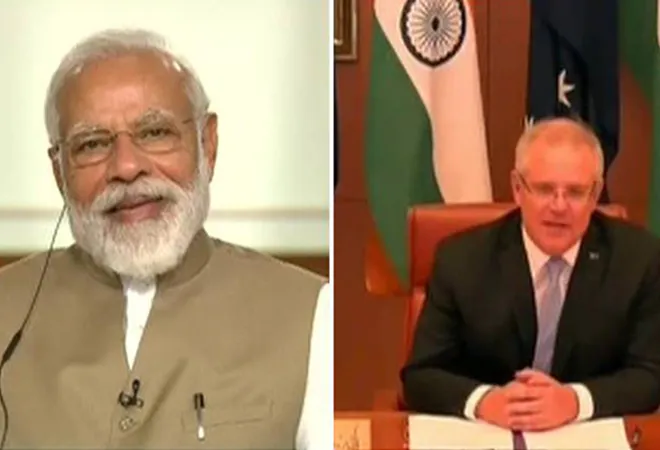
Both Canberra and New Delhi had deep concerns about the possibility that Donald J. Trump might become President of the United States, but neither really thought he would be elected. When he was, the shock – and indeed fear – was palpable. On the campaign trail and before, Trump had said things that directly challenged the interests of both Australia and India, promising – among other things – to pull out of the Trans-Pacific Partnership (TPP) and to severely restrict skilled worker visas. As a consequence, it took a while for both Canberra and New Delhi to come to terms with the new President, and neither found it easy. The early months were rocky. Australia’s then-Prime Minister Malcolm Turnbull had an angry phone exchange with the President and the details of the call leaked – allegedly by Stephen Bannon – to the media. When Narendra Modi went to Washington, D. C. in late June 2017, his encounter with Trump looked awkward, the discussion skirted around contentious issues, and the meeting produced few tangible results. And in the background, concern across the Indo-Pacific mounted about the apparent absence in the Administration of a clear strategy for the region.
Strategic Catalysis
In retrospect, however, we can see that this Trump-induced anxiety had a catalytic effect. Worries about the direction and implementation of American policy have not gone away, of course, and in some areas they have intensified as his Presidency has worn on. Both Canberra and New Delhi have serious qualms about the way in which the Trump administration is handling the relationship with Beijing and the trade war into which the US and China are now locked. But these concerns have stimulated or accelerated initiatives that might not have occurred without Trump. Canberra’s decision to press ahead with the TPP together with Japan and New Zealand, but without the US, is one. The bolstering of the strategic partnership between Australia and India is another.
The partnership does long pre-date Trump. Its origins lie in the mid-2000s, at the point at which sustained US engagement of India produced the civil nuclear deal and a defence framework agreement, and encouragement from Washington to its allies to build stronger ties with New Delhi. Fortunately, these developments coincided with renewed interest in the Australian business community in India and the opportunities its booming economy might offer. In fits and starts, ties broadened and deepened over the years that followed, especially in defence and security, as China became more assertive in the aftermath of the Global Financial Crisis and then with the rise of Xi Jinping.
The partnership has not yet reached its full potential, however, for at least three reasons. First, misperceptions and misunderstandings of each other’s relationships with China persist. Of particular concern is what some in India see as Australia’s economic ‘dependence’ on the Chinese market. They argue that the scale of Australian exports gives Beijing an effective veto over Canberra’s foreign policy, or at least a means of dissuading it from doing things of which China does not approve. Second, Canberra and New Delhi had – and still have – very different understandings of how the economic relationship between Australia and India will develop. Canberra maintains that liberalisation and deregulation are essential to boosting trade and investment, and to make those happen has pushed first for a bilateral trade deal – the so-called Comprehensive Economic Cooperation Agreement (CECA) – and then for the ASEAN-based Regional Comprehensive Economic Partnership (RCEP) deal. New Delhi’s view is rather different: it thinks the sheer size and dynamism of its economy should be enough to generate Australian interest, and so it has slow walked the CECA and pulled out of RCEP. And third, politicians, bureaucrats and analysts in both countries harbour doubts about the capacity of the other to deliver what they promise, politically or indeed militarily.
The combined Xi-and-Trump effect – if we can call it that – has not swept away these issues, but they have put them in a different perspective. Doubts and disappointments have been set aside in both capitals and efforts made to work around differences. Canberra has invested heavily in an India Economic Strategy that tries to locate opportunities for trade and investment in the absence of a CECA and Indian involvement in RCEP. It has shared details of its efforts to manage foreign interference and maintain cyber security, partly to assuage doubts about Beijing’s influence. It has also worked hard to build stronger military-to-military and security ties, not least with an annual bilateral naval exercise, first held in 2017. And it has tried to make more of the fast-changing people-to-people and community ties Australia now has with India, as it welcomes more temporary and permanent migrants from that country.
The Summit and After
The eight agreements signed at Modi’s virtual summit with Scott Morrison on 4 June displayed some of the fruits of these efforts. The Joint Statement upgrading ties to the level of a Comprehensive Strategic Partnership had no fewer than 49 paragraphs covering everything from shared values to cooperation on COVID-19, supply chains, cyber security, defence science and technology, and reforming the World Trade Organisation. The Maritime Logistics Supply Agreement was really significant: India has only a handful of these, notably with France, Singapore, and the US. So too was the vision statement on maritime cooperation, which aims to develop better links not just between their navies but also their coast guards.
It needs to be said that Australia has taken the lead in bringing much of this to the table. The relationship has long been – and remains – lopsided, with more work being done by Canberra than New Delhi. To some degree this is understandable, as the Australian side has more capacity in some areas than the Indian and Australia arguably has more to gain from closer ties, in terms of regional security and in its attempts to diversify trade and investment ties away from an increasingly coercive China. But partly it is also due to a lack of knowledge in parts of New Delhi about what Canberra has to offer, as well as a perceived status asymmetry, in which incipient great power India expects lesser powers to contribute more labour to the maintenance of bilateral ties.
Of course, real and perceived asymmetries in capacity cannot be wished away any less than differences over the virtues of economic liberalisation. But there are signs that the views of Indian diplomats and analysts about what ‘middle powers’ like Australia can offer are shifting, as New Delhi’s strategy for managing a more assertive China evolves. Rightly, the United States will continue to play a major part in that strategy, even in the near-nightmare scenario that Trump wins again in November and continues down his destructive path, simply because its capabilities still outstrips all other’s in the region and its military-technological edge persists. But it must also involve nurturing and strengthening partnerships with other states that have weight and influence, among them Australia, Indonesia, Japan, South Korea and Vietnam – and indeed Russia, for all its many faults.
The views expressed above belong to the author(s). ORF research and analyses now available on Telegram! Click here to access our curated content — blogs, longforms and interviews.




 PREV
PREV


